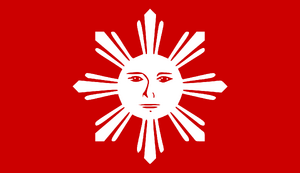
Flag of Republic of Biak-na-Bato 1897 AD/CE to 1897 AD/CE
Capitals: San Miguel, Bulacan

Continent: Asia
Official Languages: Tagalog, Spanish
Established: 1897 AD/CE
Disestablished: 1897 AD/CE
History:
The Republic of Biak-na-Bato was one of a number of unrecognized insurgent polities which existed during the time in which the Philippines was under Spanish colonial government as the Spanish East Indies. It was preceded and succeeded by two similarly unrecognized polities, the Tejeros government and the Central Executive Committee.
The initial concept of the republic began during the latter part of the Philippine Revolution, when the leader of the Katipunan, Emilio Aguinaldo, became surrounded by Spanish forces at his headquarters in Talisay, Batangas. Aguinaldo slipped through the Spanish cordon and, with 500 picked men, proceeded to Biak-na-Bató, a wilderness area at the town of San Miguel, Bulacan (now parts of San Miguel, San Ildefonso and Doña Remedios in Bulacan). When news of Aguinaldo's arrival there reached the towns of central Luzon, men from the Ilocos provinces, Nueva Ecija, Pangasinan, Tarlac, and Zambales renewed their armed resistance against the Spanish.
Unable to persuade the revolutionaries to give up their arms, Governor-General Primo de Rivera issued a decree on July 2, 1897, which prohibited inhabitants from leaving their villages and towns. Contrary to his expectations, they continued fighting. Within days, Aguinaldo and his men planned the establishment of a Republic. Aguinaldo issued a proclamation from his hideout in Biak-na-Bato entitled "To the Brave Sons of the Philippines", in which he listed his revolutionary demands as:
- the expulsion of the Friars and the return to the Filipinos of the lands which they had appropriated for themselves;
- representation in the Spanish Cortes;
- freedom of the press and tolerance of all religious sects;
- equal treatment and pay for Peninsular and Insular civil servants;
- abolition of the power of the government to banish civil citizens;
- legal equality of all persons.
On November 1, 1897, the provisional constitution for the Biak-na-Bato Republic was signed. The preamble of the constitution included the statement that:
By the end of 1897, Governor-General Primo de Rivera accepted the impossibility of quelling the revolution by force of arms. In a statement to the Cortes Generales, he said, "I can take Biak-na-Bato, any military man can take it, but I can not answer that I could crush the rebellion." Desiring to make peace with Aguinaldo, he sent emissaries to Aguinaldo seeking a peaceful settlement. Ironically, nothing was accomplished until Pedro A. Paterno, a known turncoat and a lawyer from Manila, volunteered to act as negotiator.[citation needed]
On August 9, 1897, Paterno proposed a peace based on reforms and amnesty to Aguinaldo. In succeeding months, practicing shuttle diplomacy, Paterno traveled back and forth between Manila and Biak-na-Bato carrying proposals and counterproposals. Paterno's efforts led to a peace agreement called the Pact of Biak-na-Bato. This consisted of three documents, the first two being signed on December 14, 1897, and the third being signed on December 15; effectively ending the Republic of Biak-na-Bato.
On November 16, 1937, a 2,117-hectare block in the Biak-na-Bato area was declared a national park by Manuel L. Quezon in honor of the Republic. In the 1970s, Ferdinand Marcos issued orders guiding mineral prospecting and exploitation in government reservation, impacting the park's boundaries. On April 11, 1989, Corazon Aquino issued Proclamation No. 401, which re-defined the boundaries of the Biak-na-Bato National Park. The proclamation set aside 952 hectares (3.68 sq mi) hectares as mineral reservation, 938 hectares (3.62 sq mi) hectares as watershed reservation and 480 hectares (1.9 sq mi) hectares as forest reserve.